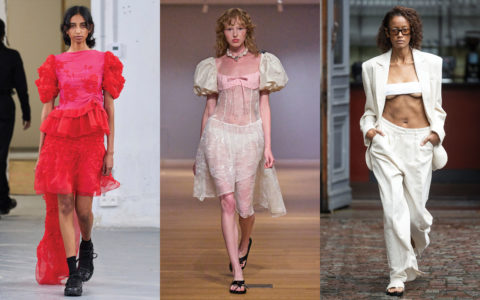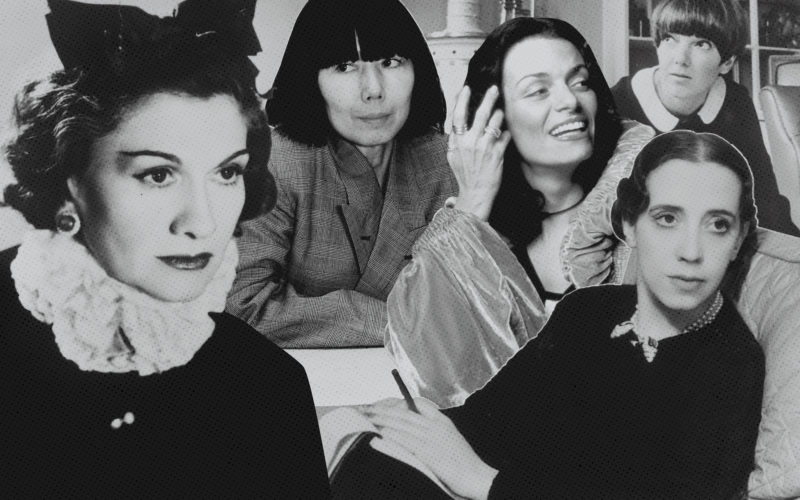Or are we just looking in the wrong places?
I saw a clip of Meryl Streep making the rounds on TikTok recently. She was on a panel hosted by The Washington Post. “Women have learned to speak the language of men; they have lived in the house of men all their lives,” she said, underscoring women’s fluency within a man’s world — in Hollywood and otherwise. “Women speak men. But men don’t speak women.”
Over on the runways, however, men seem to be able to “speak” women just fine. Gucci, Balenciaga, Louis Vuitton, Valentino, Burberry, Saint Laurent, Celine, Bottega Veneta and Loewe are all major luxury brands headed up by male creative directors. And now, with the departure of its longtime lead Sarah Burton, Alexander McQueen joins the already lengthy list.
These high-up designers, like Jonathan Anderson at Loewe and Gucci’s recently appointed Sabato De Sarno, aren’t just speaking; they’re telling — telling women what to wear. Along the way, they’re racking up billions in sales, courting celebrity favour and earning breathless press coverage. Luxury fashion marches to a beat so familiar that it sounds like a broken record. Givenchy’s Clare Waight Keller? Replaced by Matthew Williams in 2020. Gucci’s Frida Giannini? Replaced by Alessandro Michele in 2015. And even Phoebe Philo, who didn’t just speak the language of women’s clothes but single-handedly rewrote it, was famously — and contentiously — succeeded by Hedi Slimane.
So, this invites the easy question “Where are all the women in fashion?” Why aren’t they getting a bigger share of these esteemed roles at storied houses?
“I think they’re everywhere,” says Mosha Lundström Halbert, a journalist and podcast host who also breaks down the latest fashion headlines on her popular TikTok account NewsFash. “Women aren’t just behind the scenes; they’re also behind the seams,” she says, alluding to the fact that at most fashion houses, the head seamstress is usually a woman. This all goes back to the roots of handicraft, sewing and dressmaking, which have historically been women’s pursuits.
Lundström Halbert also brings up the fact that four of the most profitable (not to mention culturally relevant) fashion houses today — Chanel, Hermès, Prada and Dior — are helmed by women. And that’s nothing new. “Throughout history, there have been examples of women who were able to build these juggernaut businesses because of their keen understanding of what a woman wants to wear,” says Lundström Halbert, pointing to Coco Chanel herself, who popularized straps on handbags, and Elsa Schiaparelli and Sonia Rykiel, who pioneered the use of jerseys and knits to enhance comfort. Mary Quant gave the world the miniskirt; Norma Kamali, the shoulder pad. And recall Donna Karan, Diane von Furstenberg and Liz Claiborne — an unofficial holy trinity who dictated how fellow women dressed for work and leisure and helped define the fashion of the back half of the 20th century.
“If the proof is in the pudding — and the numbers don’t lie — and the success metrics are there, then why aren’t women getting these major roles?” wonders Lundström Halbert. “Sarah Burton is a treasure in the industry. I think it was such an oversight not to look for another female talent,” she muses, tossing out names like Iris van Herpen, Simone Rocha and Dilara Findikoglu as potential replacements at Alexander McQueen.
Alexander McQueen is owned by Kering, a luxury conglomerate that also counts Gucci, Balenciaga, Bottega Veneta and Saint Laurent as jewels in its crown, and with the replacement of Burton by Seán McGirr, all of these are now run by men.
“It’s very convenient to point fingers at a boardroom of men,” comments Timothy Chernyaev, an L.A. stylist and TikTok fashion critic whose account, Relax It’s Only Fashion, breaks down runway shows and offers commentary on larger industry moves. “But they’re hiring from their competitors’ houses.” It’s true: McGirr worked at JW Anderson; Pieter Mulier and Matthieu Blazy (who oversee Alaïa and Bottega Veneta, respectively) both worked under Raf Simons at Dior and Calvin Klein; and Daniel Roseberry, the creative director of Schiaparelli, reported to Thom Browne. “So it goes beyond the corporate structure; it is also in the creative structure. Are you hiring women?” Chernyaev wonders.
“Men are cliquey in the same way that women can be cliquey,” he continues. “They have been working together for a long time, and they all have the same sort of visual vocabulary.” And this echo chamber of sameness doesn’t just shut out women; it shuts out other groups, too — most notably people of colour. In a fashion world largely dictated by designers who all seem to be cut from the same cloth, Maximilian Davis at Ferragamo and Olivier Rousteing at Balmain are just a few exceptions to the norm. When looked at through a more intersectional lens, hiring a Western European woman with decades of experience to fill a position for which she’s well qualified stops feeling like a major win for inclusivity and more like the minimum standard.
Chloé, a house that has historically favoured women designers, recently tapped Chemena Kamali as its new creative director, following the departure of Gabriela Hearst. Before her appointment, Kamali was the womenswear director at Saint Laurent, working under Anthony Vaccarello. “Now that I know a woman was the design director for women’s ready-to-wear at Saint Laurent, it makes sense,” says Chernyaev. “Because it looks like it was designed by a woman.”
Is there a difference between the work of women and the work of men? Male designers very much feel like they are always “for hire,” Lundström Halbert says, “whereas women have cultivated this community and cult of personality around them and their work and a fierce loyalty from their customers.”
For proof, look no further than Philo, who returned with her own line after a six-year hiatus. The pieces — including a simple leather tote priced at $8,000 — sold out almost instantly. “Philo can take however long she wants and still her loyalists will flock because of her work, her reputation and her legacy,” says Lundström Halbert.

If you look just beyond the conglomerate-owned luxury labels, women are, in fact, everywhere. There is Rei Kawakubo of Comme des Garçons; Sandy Liang and Cecilie Bahnsen, who are known for not only their feminine whimsy but also their commercially successful collaborations with accessible brands Baggu and Asics; Maria Cornejo, who won the CFDA’s Lifetime Achievement Award for her label, Zero + Maria Cornejo; Catherine Holstein’s Khaite, which carried the torch for considered womenswear in Philo’s absence; and Smythe, Marie Saint Pierre and Tanya Taylor of the Canadian set.
Birgitte Herskind is the Danish designer behind Herskind, which she runs with her daughter, building a modern heritage brand on her own terms. What would she do, hypothetically, if asked to head up a luxury house? “I would be flattered,” she says. “But Herskind is my heart; by having my own brand, I have freedom.” Lundström Halbert, who also happens to be the daughter of well-known Canadian designer Linda Lundström, opines that an eponymous self-run brand is ideal for a female designer who wants to create a legacy. “For the most part, the female designers who go down in the history of fashion have their names on their products,” she says. “Sometimes, working for another brand might make you largely forgettable.”
Maybe women aren’t being offered fashion’s top roles — or maybe they don’t want them in the first place. “Job security in the industry is at an all-time low,” says Lundström Halbert. When the relentless pace and commercial pressure of these roles are such heavy considerations, why not just do your own thing? “I see the next generation of women in fashion as brave, and by brave, I mean brave enough to demand a balance between work and private lives,” adds Herskind. “Brave to follow their intuition. Brave to be more creative.”
Women live in a world where so many of the products we rely on — from tampons to car seat belts — are not designed by us. Wouldn’t it be nice to hear fashion speak, with women doing their fair share of the talking?
This article first appeared in FASHION’s April 2024 issue. Find out more here.
